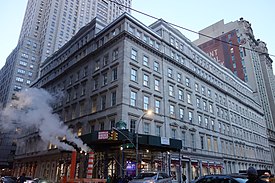| 280 Broadway | |
|---|---|
 | |
 | |
| Alternative names | A.T. Stewart Dry Goods Store Marble Palace Sun Building |
| General information | |
| Architectural style | Italianate |
| Address | 280 Broadway |
| Town or city | Civic Center, Manhattan, New York |
| Country | United States |
| Coordinates | 40°42′51″N 74°00′21″W / 40.71417°N 74.00583°W |
| Construction started | 1845 |
| Completed | 1846 |
| Renovated | 1850–1851, 1852–1853, 1872, 1884, 1995–2002[1][2] |
| Height | 77.53 ft (23.63 m) |
| Technical details | |
| Floor count | 7 |
| Design and construction | |
| Architect(s) | John B. Snook Joseph Trench |
| Renovating team | |
| Architect(s) | Trench & Snook (1850–1851, 1852–1853) Schmidt[a] (1872) Edward D. Harris (1884) Beyer Blinder Belle (1995–2002)[1][2] |
| Website | |
| Official website | |
A. T. Stewart Dry Goods Store (Sun Building) | |
New York City Landmark No. 1439
| |
| Location | 280 Broadway, Manhattan, New York |
| Coordinates | 40°42′51″N 74°00′21″W / 40.71417°N 74.00583°W |
| NRHP reference No. | 78001885 |
| NYCL No. | 1439 |
| Significant dates | |
| Added to NRHP | June 2, 1978 |
| Designated NHL | June 2, 1978 |
| Designated NYCL | October 7, 1986 |
| References | |
| [3] | |
280 Broadway – also known as the A.T. Stewart Dry Goods Store, the Marble Palace, the Stewart Building, and the Sun Building – is a seven-story office building on Broadway, between Chambers and Reade streets, in the Civic Center neighborhood of Lower Manhattan in New York City. Built from 1845 to 1846 for Alexander Turney Stewart, the building was New York City's first Italianate commercial building and the first department store in the United States. The building also housed the original Sun newspaper from 1919 to 1950 and has served as the central offices for the New York City Department of Buildings since 2002. It is a National Historic Landmark and a New York City designated landmark.
Trench & Snook had designed the original store at the corner of Broadway and Reade Street, as well as two annexes in the early 1850s; further additions were designed by "Schmidt"[a] in 1872 and Edward D. Harris in 1884. The facade is made of Tuckahoe marble and is divided into multiple sections, allowing the various expansions to be designed in a similar style. The ground level contains pilasters and columns, which originally framed plate-glass walls. The facade also contains a four-sided clock and a two-sided thermometer, which were added when the Sun occupied 280 Broadway. When the building was completed, the wholesale and retail departments of Stewart's store were arranged around a central rotunda. The current interior dates to 1884, when the rotunda was destroyed and the building was converted into offices.
Stewart's store opened on September 21, 1846, and grew rapidly in the next two decades. The store's retail division moved uptown in 1862, but the wholesale division remained there until 1879. Henry Hilton bought the building from Stewart's widow in 1882 and converted the building to offices. Hilton sold the building in 1908 to Felix Isman, who lost it to foreclosure four years afterward. The newspaper moved into 280 Broadway in 1919 and renamed it the Sun Building in 1928. After the Sun vacated the building in 1950, there were various plans to demolish the building, which did not come to fruition. Instead, the building has been used as city government offices since 1965, and it was rehabilitated from 1995 to 2002.
- ^ a b Cite error: The named reference
aiawas invoked but never defined (see the help page). - ^ a b Cite error: The named reference
nyclandwas invoked but never defined (see the help page). - ^ "Sun Building". Emporis. Archived from the original on April 13, 2017. Retrieved April 13, 2017.
{{cite web}}: CS1 maint: unfit URL (link)
Cite error: There are <ref group=lower-alpha> tags or {{efn}} templates on this page, but the references will not show without a {{reflist|group=lower-alpha}} template or {{notelist}} template (see the help page).